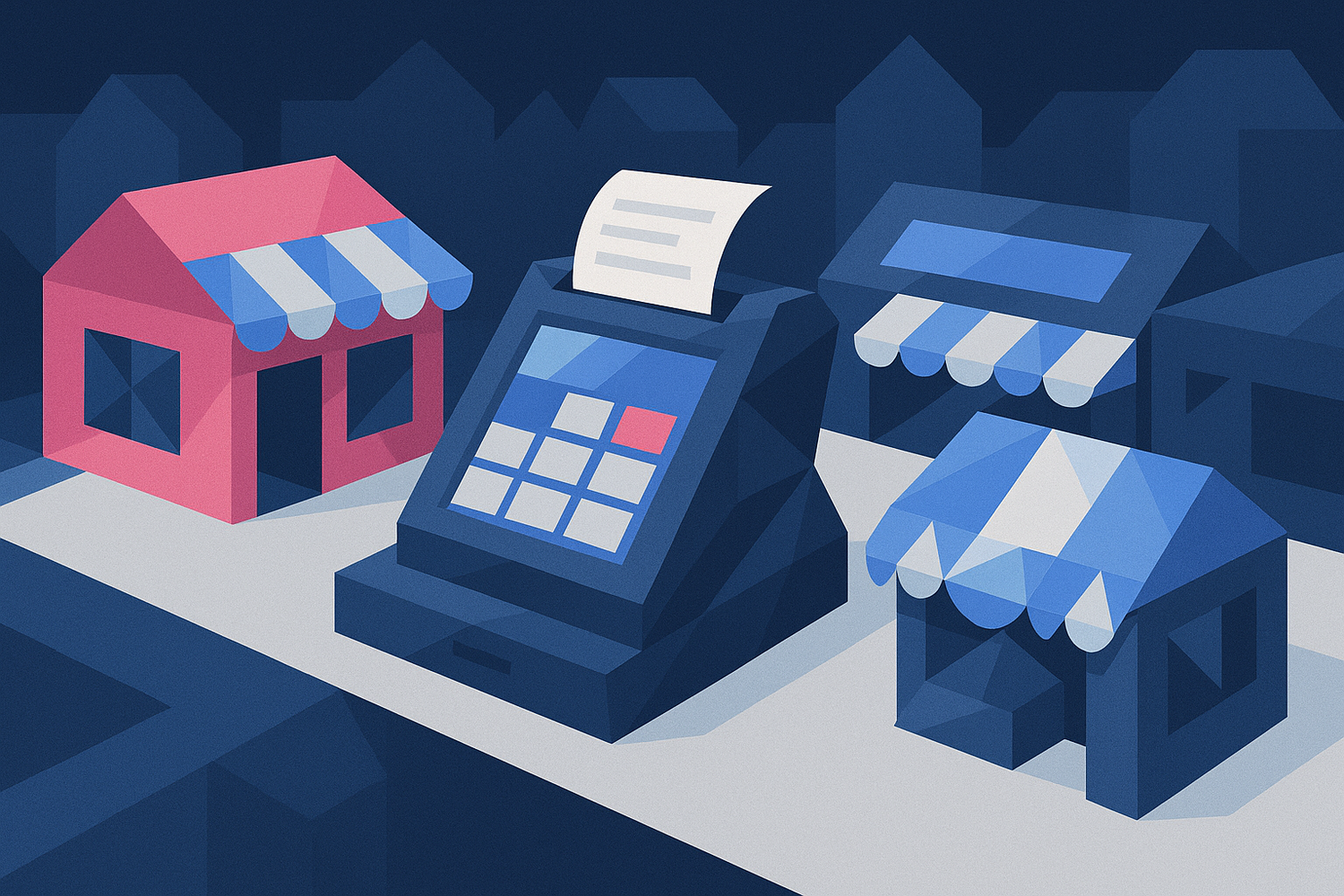Shopify POS is the POS system for modern retailers who want to seamlessly connect online and brick-and-mortar stores. Whether you're a pop-up store, boutique, or flagship store, the system is directly integrated into the Shopify ecosystem and supports you in all relevant sales processes.
It offers retailers the opportunity to sell products seamlessly and locally. Customers also experience a consistent brand presence. But how do you best get started with Shopify POS, and is it even a suitable solution for your needs?
The content is based on the experiences of Ferry Hötzel, co-founder of OpenFiskal , our recommended solution for legally compliant use of Shopify POS.

Ferry worked at Shopify for over six years and was responsible for the international rollout of Shopify POS. With OpenFiskal, he now enables legally compliant use of Shopify POS in Germany, Austria, and soon in other countries – including certified TSE, RKSV, compliant Z-receipts, and a cash book.
- What is Shopify POS?
- The top reasons for Shopify POS
- Shopify POS Hardware: What You Really Need
- Shopify POS Pro vs. Lite: The Comparison
- How to use Shopify POS legally
- Shopify POS in everyday life: Proven routines & tools
- Fact Check: The most common prejudices against Shopify POS
- Setting up Shopify POS: How it works
1. What is Shopify POS?
Shopify POS is Shopify's point-of-sale system for brick-and-mortar retailers. POS stands for "point of sale," the location where customers purchase a product or service. While Shopify's core focus is on digital commerce, POS expands the ecosystem to include physical sales: in stores, at events, or in temporary retail spaces.
In German, "POS system" is a broad term. Depending on the context, it can refer to the POS app, the hardware, or the entire setup. Shopify POS is primarily a sales application connected to the Shopify admin. It runs on tablets or smartphones and connects the online store with the point of sale.
The core idea is that retailers don't have to differentiate between online and retail. Products, customer data, inventory, and payments are managed seamlessly across channels in the Shopify backend.
Shopify POS is available in two versions:
- POS Lite , which is included in every Shopify plan
- POS Pro , which offers additional features for teams, reports, and multi-store setups
In the coming sections of this blog article, we will explain the specific differences, which hardware is compatible with Shopify POS, and how legal requirements can be implemented.
2. The most important reasons for Shopify POS
For many retailers, Shopify POS is more than just a point-of-sale system. Rather, it can be used as a tool for selling products, managing inventory, and centrally serving customers in both e-commerce and retail. Why should you use Shopify POS? We'll give you four key reasons.
2.1. Seamless integration of online shop and retail
Shopify POS is a fully integrated sales channel within the Shopify admin. Product data, inventory, customer profiles, discounts, and coupons are automatically synchronized—regardless of whether they are used in the online store or in the physical store. This simplifies processes and unifies the purchasing experience.
2.2. Fast start and flexible scaling
The Shopify POS app can be activated as a sales channel with just a few clicks. This eliminates the need for a separate system, complex interfaces, and long-term contracts. Pop-up stores can be set up in just a few hours. At the same time, the system is capable of growing with your brand: from the first store to 250 or more locations.
2.3. Sustainable infrastructure
Popular brands like waterdrop and 1. FC Union Berlin demonstrate how Shopify POS works in practice: New products are launched directly in-store, customer data from online and offline flows into a central CRM, and loyalty programs run across channels. Shopify POS is seen not just as a POS system, but as a strategic tool for community building and sustainable growth.
2.4. Shopify Payments integration
With Shopify POS, you can also benefit from Shopify Payments when selling in-store, including lower transaction fees, support for common payment methods like credit cards and Apple Pay, and unified payment processing. You can find detailed information on the benefits of Shopify Payments in our guide.
3. Shopify POS Hardware: What You Really Need
Shopify POS can be deployed on standard hardware. Experience shows that many retailers start with an existing iPad or Android device and gradually add to their hardware.
Shopify POS expert Ferry puts it this way:
"Hardware often only becomes important when it malfunctions in live operation. By then, it's too late. That's why a stable setup is essential from the start."
– Ferry, co-founder of OpenFiskal
These basic building blocks are part of a typical POS setup in retail:
- Tablet or smartphone as control for the Shopify POS app
- Card terminal for contactless and chip-based payments
- Cash drawer for cash payments & change
- Receipt printer for customer receipts
- Barcode scanner
- Wi-Fi connection with stable internet connection
The specific choice depends heavily on the application scenario. It matters whether you want to sell mobile, set up fixed checkouts, or operate multiple stores. Legal requirements such as TSE integration also influence the hardware decision.
4. Shopify POS Pro vs. Lite: The Comparison
Shopify offers two versions of its POS system: POS Lite and POS Pro. While POS Lite is included in every Shopify plan and maps basic in-store sales processes, POS Pro is aimed at retailers who want to specifically structure, analyze, and further develop their brick-and-mortar processes.
The experience of POS system expert Ferry makes it clear: Many stores start with POS Lite and later upgrade to POS Pro as operational requirements grow. POS Lite quickly reaches its limits, especially when it comes to role allocation within the team or detailed reporting.
The following overview shows Shopify POS Lite and Pro in comparison:
| feature | POS Lite | POS Pro |
|---|---|---|
| Sale in store | Yes | Yes |
| Role-based employee rights | No | Yes (e.g. for returns, discounts, access to reports) |
| Access to reports in the POS | base | Advanced reports |
| Managing multiple locations | Restricted | Fully supported |
| Integration of POS apps | Partially | Unrestricted access |
| Inventory and inventory tools | No | Yes (including inventory function in POS Pro) |
Ferry particularly emphasizes the importance of operational processes, such as inventory or employee management, that can be mapped directly at the point of sale thanks to Shopify POS Pro. Shopify is also continually improving its reporting.
4.1. What are the costs of Shopify POS?
The basic version, Shopify POS Lite, is included free with all Shopify plans and is suitable for smaller setups, temporary retail spaces, or pop-up stores. Those who want to use advanced features such as employee roles, Smart Grid customization, warehouse locations, reports, or omnichannel capabilities can activate the Pro plan.
Shopify POS Pro costs €79 per month per location with monthly billing ( €59 annually ) and can be added or deactivated at any time. You can also try out the features with a 14-day trial .
The Shopify POS app itself is available for free in the App Store (iOS and Android). Costs only arise with the Pro version or additional hardware.
5. How to use Shopify POS legally
In brick-and-mortar retail, extensive legal requirements apply to POS systems in Germany, Austria, and Switzerland. If you use Shopify POS, we recommend familiarizing yourself with topics such as the KassenSichV (Cash Register Security Regulation), TSE (Transactional Security Regulation), DSFinV-K ( German Financial Services Regulation), and the new cash register reporting requirement early on.
OpenFiskal co-founder Ferry is familiar with these requirements from years of experience – both from his time at Shopify and as a provider of the specialized app solution for legally compliant POS operations in the DACH region . He particularly emphasizes these legal requirements:
| Legal requirement | What is required | Relevance for Shopify POS users |
|---|---|---|
| KassenSichV | Every digital cash register must have a TSE | Shopify POS requires a certified TSE |
| TSE (Technical Security Device) | Signs every transaction tamper-proof | A TSE is mandatory if the system is technically capable of recording cash payments |
| DSFinV-K | Structured export for audit purposes | Must be available upon request |
| Obligation to issue receipts | Every sale must be completed with a receipt | Also applies to pure card payments |
| Daily closing / Z-receipt | Daily report with unique numbering | Serves as a basis for accounting and auditing |
| Cash register reporting obligation (from 1 July 2025) | Every cash register and TSE must be registered with Elster and kept up to date, e.g., when devices are replaced | Applies to new and existing cash registers |
5.1. Setting up Shopify POS TSE-compliant
Shopify offers its own solution, the TSE app, which signs transactions, creates DSFinV-K exports, and displays TSE data on receipts. However, implementation requires numerous manual steps: Receipts must be photographed, reports forwarded, and exports manually compiled.
OpenFiskal offers an alternative solution that is particularly designed for efficiency, completeness and scalability:
- Automated daily reports in PDF format with detailed breakdown
- Digital receipts: Automatic creation of digital receipts in PDF format, also sendable by email with compliant TSE or RKSV signature
- Cash book function for documenting cash withdrawals and deposits
- Elster notification directly via the app, without a separate Elster login
- Notifications when iPads change branches or TSEs are missing
- Overview of all cash registers and TSEs with serial numbers and certification data
This form of control is a great advantage, especially in growing retail structures or where devices are frequently changed (e.g., during pop-ups or store openings).
Ferry reports from experience that tax office audits cover not only the TSE data, but also the processes surrounding daily reports, receipt issuance, and cash balances. If reports are missing or figures are incomplete, this can raise questions.
5.2. Shopify POS and the cash register reporting requirement (from July 2025)
Regardless of whether you operate multiple locations, sell from a single branch, or only at events, you must report each cash register, including the TSE, serial number, commissioning date, and location. Any changes must be updated within 30 days.
Here, too, we recommend OpenFiskal with its own reporting flow app as a proven and legally compliant solution for implementing the reporting requirement for cash register systems. This app automatically reads the relevant data and prepares it for transmission to Elster.
6. Shopify POS in everyday life: Proven routines & tools
The true strength of a POS system only becomes apparent in everyday use: How quickly does the daily closing run? How are returns handled? Shopify POS is not only easy to use, but can also be expanded with apps. This helps prevent errors and automate processes.
6.1. Typical retail routines with Shopify POS
- End of day: The cash register day is closed in the POS, the Z-receipt is created, and the data is signed (automated when using a TSE).
- Returns processing: Returns can be processed using the original receipt, the customer profile, or manually – including partial refunds or exchanges.
- Cash bookkeeping: With solutions such as OpenFiskal, the cash book is automatically generated and stored digitally.
- Inventory: Items can be recorded, counted, and reconciled using scanners – directly at the POS or via a connected app.
- Reports: Sales, employee actions, and product data are available in real time – directly on the device or in the Shopify Admin.
- Team management: User roles, rights and shift schedules can be defined and tracked (POS Pro).
6.2. Tool recommendations for a strong POS setup
At tante-e, we recommend the following Shopify POS apps, which meet legal requirements, integrate practical features, and significantly simplify your everyday life as a retailer.
| App / Solution | Area of application |
|---|---|
| OpenFiskal | TSE, daily reports, cash book, Elster export |
| Reporting flow | Automated cash register reporting to the tax office |
| Pathway Solutions | DATEV export, accounting preparation |
| EasyTeam | Shift planning, time recording, employee management |
| Loyalty apps | Point systems, discounts, cross-channel customer loyalty |
7. Fact Check: The most common misconceptions about Shopify POS
There are some persistent misconceptions surrounding Shopify POS. How is the POS system actually used in practice, and what are expert Ferry's experiences with it? We analyze the most common misconceptions.
False: “Shopify POS is only for small brands or pop-ups”
The opposite is true. Brands like Motel a Miio operate over 30 stores with Shopify POS – spread across various countries, with clear roles, daily reports, and reliable checkout processes. The system is also used for international rollouts. 1. FC Union Berlin and nkm also rely on Shopify POS.
False: “From four stores onwards it becomes confusing”
With POS Pro, fixed user roles, a clear checkout structure, and tools like OpenFiskal , retailers maintain an overview even with multiple checkouts. Waterdrop, for example, relies on this very structure to efficiently manage brick-and-mortar growth.
False: “Returns are too complicated”
Returns can be processed directly at the POS, including via receipt, customer profile, or manually.
False: “Not accountable”
With dedicated tools such as reporting flow, data can be transferred directly to the tax office or financial administration – including cash register reporting, DATEV-compatible export, and TSE linking.
8. Quick Start Guide: Set up Shopify POS and get started right away
In the tante-e podcast, expert Ferry describes how easy it can be to get started with Shopify POS:
"You don't need your own IT team, complex training, or a long-term contract. You install the app, log in, and you can sell."
So that you can get started right away, here are the most important steps at a glance:
- Activate POS as a sales channel:
In the Shopify admin, under "Sales Channels," add the "Point of Sale" channel. The app is automatically included in every Shopify plan (POS Lite). - Install POS app on device:
On your device, such as an iPad, search for "Shopify POS" in the App Store (iOS or Android) and install it. After logging in, the device will be automatically linked to the store. - Release products for the POS channel:
Only products assigned to the POS sales channel appear in the POS system. Selection can be controlled via the product selector in the Shopify admin: Select the relevant products, go to the additional options, and select "Include in Sales Channels." There you can activate Point of Sale. - Activate TSE and operate it legally:
Shopify offers its own TSE app, but many well-known brands rely on OpenFiskal . You can add and set up both solutions to your store via the Shopify App Store. - Setting up hardware:
To set up your POS hardware, go to Settings in the Shopify POS app menu. This will display the "Set up hardware" menu item, which will guide you step-by-step through the process.
9. Conclusion and next steps: Using Shopify POS legally and scalably
Shopify POS has long been more than just a simple POS app. Combined with the right setup, appropriate extensions, and clearly defined processes, it forms the central interface between your online store and brick-and-mortar stores.
9.1 Your next steps
- Test Shopify POS:
The Shopify POS Lite variant is included in every Shopify plan and is ideal for gaining initial experience in the store. - Extend the tool stack:
Our top recommendation, OpenFiskal, complements Shopify POS where legal compliance, accounting, or team processes require additional depth. Book a free demo and familiarize yourself with the features.


